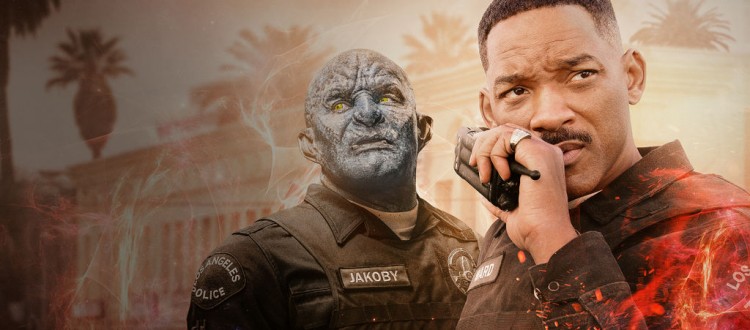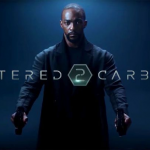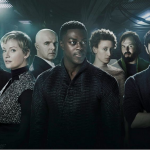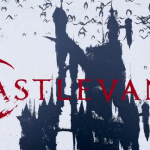Bright: Reviewed
Director: David Ayer
Starring: Will Smith, Joel Edgerton, Noomi Rapace
Bright, on first principles, should work with minimal assembly required. It promises to be Bad Boys meets Alien Nation but also Shadowrun. I am good with all of those things. Likewise, its premise is perfectly suited to a two-hour popcorn flick: a magic wand of unspeakable power is turned loose in a version of urban fantasy Los Angeles and only buddy cops Smith and Edgerton, mismatched as a Human and an Orc, can save the day. Yet here we find ourselves with critics panning the movie as derivative junk and fans proclaiming the exact opposite. I think I can summarize the core of this debate with the below line from Bright.
As an antecedent to a second act gun fight, Will Smith delivers the following line with perfect aplomb to co-star Joel Edgerton.
“We’re going to titty bar gun fight die.”
I can only imagine two responses to such a stroke of dialogue. The first is genuine laughter on hearing the 49-year-old star of The Fresh Prince of Bel Air and The Pursuit of Happyness say “titty bar” to his “diversity hire” orc partner. The second is to roll one’s eyes as the movie triples-down on showing LA’s defining characteristics being ghetto strip clubs populated by organized criminals who are exclusively Black and Latinx.
What drives this movie from the realm of urban fantasy and into the darker wilds of mediocrity is that by the time the above gun fight unfolds, I didn’t know where the movie wanted me to place my sympathy. Should I identify with Officer Ward, the beat cop five years from retirement? He’s a fellow so poor his wife has to use napkins as coffee filters. Would that Ward, the one-liner zinging family man, didn’t utter the battle cry of “fairy lives don’t matter” before bludgeoning a fairy – realized as buzzing pests here in Middling Earth – to death. There are a lot of words in the English language, and those are the ones they chose for the final cut.
The natural consequence of Ward’s “I’m not a racist, but” routine should be to drive my sympathy to Officer Jakoby, the first Orc on the LAPD. And I may have got there if Jakoby’s wasn’t so unremarkable as to be upstaged by Bright’s preoccupation with world building. For an audience where high fantasy is the fodder of satire and spoof, the world building graffiti of the opening titles does more than enough to set the stage for this movie. An unwillingness to trust the audience to meet the movie half way leads to the first hour coming off as the voice of a dungeon master who stayed up until 3am writing their first campaign. “Do you get it?” he shouts to his players.
How can we show that elfs run the world? Well let’s take a drive through the literal walled garden of “Elf Town” and show all the cell phones, glimmering skyscrapers, and couture outfits on people with pointed ears. Will this prove relevant later in the movie? Ha, no. Can we start the movie now? Ha, no. Now we need to learn about the backstory of why Orcs are persecuted through a ten minute arrest sequence of a crazy guy with a sword raving about the Dark Lord. Who is the Dark Lord? Doesn’t matter. Save that for the sequel.
Yet it would be dishonest to say that the movie’s framework, mapping the long-arc of high fantasy into our world, isn’t appealing. Elves can run the world through a greater number of “brights” aka magic users being born to their race. Humans, centaurs, and at least six other races occupy a secondary role given their smaller proportion of magic users. Orcs fill the role of social pariah and generic racial stand-in because at some point they, as a people, sided with the aforementioned Dark Lord during some great Tolkienesque battle. A battle which, no doubt, would have been infinitely more interesting to watch than Bright. It’s a cool framework, but that’s all it is. So much of the movie presents as the first draft of an undergraduate creative writing project filled with margin comments asking, “this is nice but so what?”
If Orcs are a marginalized minority, and if this fantasy world is supposed to seamlessly map on to our world’s political and cultural landscape, then the notion of Nick Jakobi as the first “diversity hire” Orc cop seems more than a century past its due date. History lesson: in 1886 Robert W. Stewart became the first African American officer in the LAPD. Did I know that because I have a graduate degree in history? No. I know that because we live in a world where Google is a thing. It took ten seconds to undermine Bright’s running conceit. It’s not the fantasy elements that stress the audience’s ability to suspend disbelief, but the idea that a staple of the mid-20th century cop story is still underwriting a contemporary movie.
The choice to build high fantasy over the tropes of a contemporary police procedural, absent any concessions to the creation of a meaningful hybrid culture for the film to inhabit, screams of an auteurial arrogance. It’s the work of someone, not naming names, desperately trying to wipe Shadowrun’s fingerprints off their script. The result is a movie rife with obvious metaphors and unrealized potential. Yet the potential is still there, so I can see why Netflix ordered a sequel. For this movie, a half-decent script doctor could have fixed the plodding pace and excessive world building to a point where the movie didn’t depend on Will Smith making titty bar editorials, hilarious though they may be, to pass muster. It is singularly the force of Big Willie’s style that lifts Bright from the bottom of the bin and into a marginally passable place.













